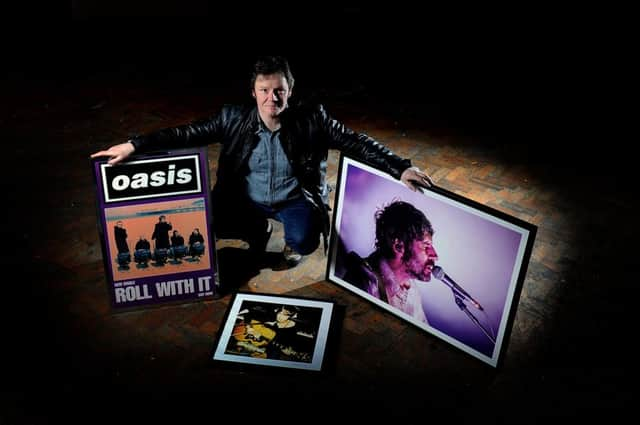Sleeve notes: The man who designed Britpop


The young man in question was Richard Ashcroft, posing for what would become one of the most popular and profound pieces of cover art produced for chart-topping Brit band the Verve.
And the man behind the camera lens was Brian Cannon, founder and creative force behind Microdot, a company responsible for much of the artwork that defined guitar music of the Nineties and Noughties.
Advertisement
Hide AdAdvertisement
Hide AdYears earlier, Brian had strolled those same city streets during his time as a graphic design student at what was then Leeds Polytechnic. So when he conceived the idea for the cover of Verve single This is Music, he knew exactly where to go.
“We shot it there because it was one of the only places in the country with those back-to-back houses. I think they’re illegal now,” says Brian, who also counts Oasis’s Definitely Maybe among his back catalogue. “I’d remembered them from my time there. Harold Street and there were other Harolds, I don’t know if they are still the same now.”
That black and white image of a lone Ashcroft in deepest Burley encapsulates the spirit of Microdot and a time when a bunch of young Northerners exploded on to the music scene.
They were proud, defiant, working class meets cutting edge. Armed with his camera, Cannon was there to capture it all. But it was more than a dash of nominative determinism that propelled him to success.
Advertisement
Hide AdAdvertisement
Hide Ad“My dad was always good at drawing but he was a miner, so he never got the chance to fulfil his potential. I was always pretty creative and into that sort of thing, and I loved my music.”
Inspiration came in the form of the Sex Pistols’ Never Mind… cover. “That changed everything for me. From then on, I knew I wanted to make artwork for bands like them,” he adds.
Luck also played a part. A chance encounter with Noel Gallagher in a lift, during which the pair bonded over a mutual appreciation of trainers, resulted in Brian becoming Oasis’s go-to man during the glory days of Britpop. “I’d taken my mum to Rome and bought a pair of trainers while I was there,” Brian explains. “Noel got in and asked me where I got them from, and that’s how we got chatting.”
Oasis and the Verve are arguably the most impressive names that Microdot has worked with, but the company also counts the Smiths’ Johnny Marr, Cast, the Super Furry Animals and Suede among its clients, with its repertoire also extending into graphic design and filmmaking.
Advertisement
Hide AdAdvertisement
Hide AdBrian’s design for Definitely Maybe was number 14 in Q magazine’s “The Hundred Best Record Covers Of All Time” list, first published in 2001. From the cover of Some Might Say, which features his own father and mother, to the Super Furry Animals Fuzzy Logic – a montage of photos of Welsh-born drug smuggler Howard Marks – behind each piece is a fascinating story.
He struggles to choose a favourite, however. “That’s like asking a father which of his children he likes the best,” says Brian.
Each story is told in the Microdot 25th anniversary exhibition, which takes over former Leeds nightclub La Boheme from today, after previously being showcased in Brian’s native Wigan, Manchester and London.
Despite the fact that the bulk of Microdot’s work is with bands with their roots firmly on the other side of the Pennines, the Yorkshire connection runs deep. Music lovers may be surprised to learn, for instance, that the distinctive black and white Oasis logo, as synonymous with the band as circular sunglasses, was dreamt up in Sheffield, backstage at Hallam University after one of the band’s earlier gigs.
Advertisement
Hide AdAdvertisement
Hide AdOr that, after flying all the way to Los Angeles to photograph Oasis for the cover of Whatever, only to be told the band had fallen out, Brian took the “money shot” – a plush green meadow meeting a dusky pink sky – atop a hill near Barnsley. “I travelled 10,000 miles and ended up shooting it in Penistone,” he laughs.
The photographs, artefacts, memorabilia and promotional materials that make up the impressive Microdot exhibition are a must-see for anyone who ever uttered the words “mad for it”, or swaggered down their street à la Ashcroft in the video for Bittersweet Symphony.
The show also features work from Brian’s long-term project Northern Soul – A Photographic Journey – striking black and white images of the modern-day Northern Soul scene, still alive and high-kicking on dancefloors across the north of England.
“I’ve lived in Yorkshire, so I know they are the most patriotic people around,” he adds. I just hope people come along and see it.”
Advertisement
Hide AdAdvertisement
Hide AdOnce the exhibition ends its stint in Leeds, it will continue its tour of the UK and eventually venture overseas.
Tickets are on sale now for the anniversary exhibition at La Boheme, Cross York Street, Leeds, which runs until December 13. A question and answer session with Brian takes place next Friday evening; ticketsource.co.uk/microdot.